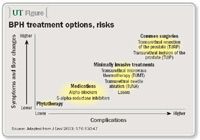Article
Minimally invasive treatments for BPH offer alternatives to TURP
A number of minimally invasive treatments are allowing millions of men to avoid a lifetime of medications or major surgical intervention for treatment of BPH.

Key Points

In 2006, an estimated 8.8 million men in the United States experienced symptomatic BPH. Treatment options include medical therapy with alpha-blocker and 5-alpha-reductase inhibitors at one end of the spectrum and, at the other end, surgical intervention, the current gold standard of which is transurethral resection of the prostate.
"The minimally invasive procedures are in the middle between medical therapy and surgical intervention," Dr. Albala explained at the 31st annual Winter Urologic Forum here. "The goal of these treatments is to achieve comparable efficacy without the morbidity and mortality associated with a TURP."

Thermotherapy
TUMT is a catheter-based procedure that uses radiant heating above 45º C to produce coagulative necrosis in prostate tissue, relieving both obstructive and irritative BPH symptoms. In cooled-catheter thermotherapy, treated tissue is displaced from the urethral surface, pushing the treatment zone deeper into the prostate. In non-cooled catheter thermotherapy, the heat is delivered to the obstructing periurethral tissue around the catheter. No definitive consensus exists as to the exact mechanism of action of microwave thermotherapy.
Grouping TUMT devices based on the presence or absence of a cooling mechanism is a widely accepted classification. However, it appears that no research has been published on whether cooling and non-cooling devices differ in their clinical effectiveness, Dr. Abala said.
In addition, while TUMT affords relief of symptoms, it does not prevent recurrence. A clinical evaluation of 157 patients treated with TUMT found overall improvement, particularly in International Prostate Symptom Scores, quality of life, and flow rate, in 53 of 108 (48%) men (Int Urol Nephrol 1998; 30:293-300). However, treatment did not alter either prostatic volume or hyperplastic growth over time.
"About 80% of patients will get some initial response to microwave therapy," said Dr. Albala. "It provides good results. After 4 to 5 years, the durability may drop to around 40% to 45% effectiveness."
Needle ablation
TUNA uses a radiofrequency device to heat the prostate to high temperatures, causing areas of necrosis. Multiple areas in the prostate can be treated to create a true defect. In a Belgian study, 188 men treated by TUNA reported significant (p<.001) improvement in symptoms at 5-year follow-up, and more than 75% of patients did not need further treatment for BPH (Eur Urol 2003; 44:89-93).





